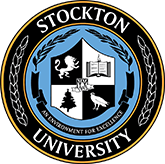Fall 2025 Issue
Unveiling Ocean Treasures
Student-Curated Shell Display Debuts This Fall
Written by students Ashley Sheets, Cambell Clark, Jodi Bolgen, Timo Abad, Justin Andell, and Luke Maguire
In Spring 2025, undergraduates Ashley Sheets, Cambell Clark, Jodi Bolgen, Justin Andell, Luke Maguire and Timo Abad worked under the supervision of Dr. Camilla Alves Souto to display the Bingham Collection of shells in the Unified Science Center.
The collection was donated to Stockton by B.J. Bingham, who spent decades of her life pursuing her passion for shell collecting and identification. She began her career as an X-ray technician and started a family with her husband in New Jersey. Eventually, the couple moved to St. Croix in the U.S. Virgin Islands, a small island in the Caribbean Sea, where her husband accepted a position at a geology laboratory operated by Fairleigh Dickinson University. Outside of work, B.J. and her husband traveled throughout the Caribbean, collecting shells from various islands. Their journeys later extended beyond the Caribbean to distant oceans, steadily expanding their collection.
The collection is primarily represented by gastropods—the largest group of mollusks, which includes abalones, conches, whelks, and cowries—and the display focused on shell morphology (shape and structure) and taxonomy (classification and identification) to help visitors appreciate the incredible diversity of forms and patterns in marine gastropods. Today, around 35,000 species of living gastropods are known, with countless more yet to be described. Over 20,000 of these species are found in marine or coastal environments. In the wild, gastropods play vital ecological roles as predators, herbivores, and food sources for both animals and humans. According to the students, the beauty and ornateness of gastropod shells cannot be understated. Like all living things, gastropods reflect the conditions of their environment.
Every shell in this collection was once part of a living organism. Each one represents a journey, a story written in form and pattern. These shells speak in silent rhythms—stories of warming and cooling, changes in water chemistry, and shifts in the food web. Some shells tell of times of abundance, when food was plentiful and growth was rapid and consistent. Others reveal times of hardship, when resources were scarce and growth slowed. Shells also carry traces of ocean acidification, salinity changes, and fluctuations in oxygen levels. We only need to learn how to listen. By creating these displays, they hope to inspire others to begin learning the language of the planet—to see the untold stories etched wordlessly into the endless forms of life with which we share our home."
Creating the Display
The creation of the display was a fairly straightforward process. Although not formally trained, the Binghams dedicated considerable time to identifying and labeling their shells to the species level. Thanks to their efforts, minimal work was needed to identify the specimens in the collection. Occasionally, the students updated the classification of some species using the World Register of Marine Species (WoRMS) database. Once the taxonomy and nomenclature were updated, they sorted the specimens by taxonomic group and shell morphology.
Initially, they wanted the display to reflect the ocean in which each shell was found. However, this proved difficult as some oceans were considerably overrepresented in the collection while others were underrepresented. As a result, taxonomy and morphology provided a more balanced framework for sorting the specimens and shaping the narrative. To enhance the display and create a more immersive experience, MARS undergraduates created artistic features such as backgrounds featuring some of their favorite marine animals (by Luke Maguire) and special pieces using printmaking (by Timo Abad).
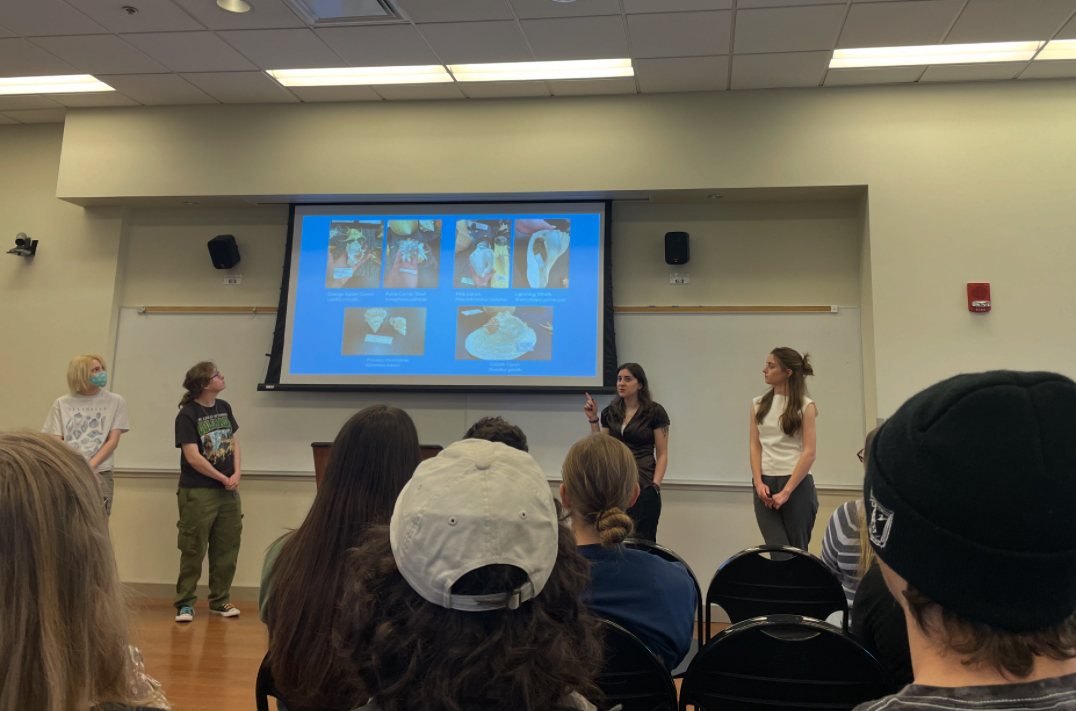
Photo credit: Camilla Alves-Souto
In the future, NAMS undergraduates will have the opportunity to help organize the collection and conduct research using the shell specimens. Public tours will also be available once the collection is fully prepared. In the meantime, the B.J. Collection display showcases the beauty of ocean life through carefully curated shells. Designed and assembled by students, this extraordinary exhibit invites everyone to explore the wonders of the sea. The display is located near the elevators on the first floor of USC1 and will be unveiled in the fall.
We hope to continue the mission set forth by B.J. She and all of us wish that everyone who beholds this beautiful and diverse collection on display will get a similar sense of joy that it has brought both to her and to us. It is with great pride and joy that we introduce this collection, which provides a visual representation and tells the wordless stories of the diverse habitats, organisms, and extraordinary experiences featured in B.J. Bingham’s collection."Jodi Bolgen and Cambell Clark.
Student Personal Impact Statements
I first began working with the collection when it was first received from B.J. Being one of the first individuals from Stockton University to handle the collection was truly a magical experience. Each shell has its own story, and it is still difficult for my mind to comprehend the vast geographic range covered in the collection. When holding the shells, I cannot help but think about the journey each shell traveled to get from where it originated to in my hands. On top of that, each and every shell is shockingly complex and beautiful in its own way. The morphology, colorations, and sheer size of each specimen are truly fascinating. My hope with this collection is to not only demonstrate our group’s admiration for the collection, but to convey B.J.’s immense dedication to education and her inspiring story.
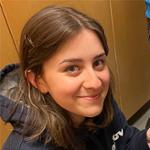
Marine Science '26
I met B.J. at the MARS symposium in the Spring of 2024. She was our guest speaker that year and shared so many memories of her family living in St. Croix, where she began her journey, and the joy she found in starting her shell collection. I first fell in love with shells while growing up on a barrier island in New Jersey. They have always been special to me. I was curious about how the creatures living inside could form such beautiful things. Each one is a masterpiece. Working on BJ’s collection of shells has been an honor and a privilege. B.J. said once that her hands touched every single one. When I think about that, it bonds us to her. The time she spent researching taxonomy, cataloging, and identifying shells shows her dedication to science, education, and the beauty and diversity of this wonderful collection. Being able to continue her legacy and learn from her is an enormous and generous gift that she has shared with us.
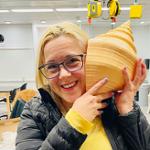
Marine Science '25
I have always loved collecting shells for as long as I can remember. Although I adore the New Jersey species, when I heard that B.J. was donating her worldwide collection of specimens, I knew I wanted to be involved. I enjoyed the entire process, but my favorite part by far was the unboxing of the shells. It was like Christmas morning. I was also lucky enough to work with such an amazing team on this project, and I can’t wait for B.J. to see it complete. A fun fact we included in our display involves the backdrops created by Luke. We each chose a marine animal to be drawn into the backgrounds. I hope this new display not only entertains Stockton’s community but also passes on our love for B.J.’s wonderful collection.
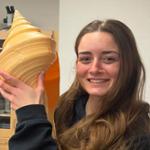
Marine Science '26
I, like my peers and B.J. herself, have always had a fascination with nature, especially that of the marine world. Going into my second semester here at Stockton, I was so excited to learn I could be a part of this project. I immediately accepted the offer to work with everyone. I have a deep love for nature and art, and this was an opportunity to use both of those passions together. I worked on the background displays for our exhibit. I asked the group what animals they wanted to be included in my drawings. Going off of animals that live in the ecosystems our shells do, I went to work. I started sketching the animals, took a photo, and entered them into Fire Alpaca (the program I use). After taking measurements of the display cases, I converted inches to pixels and started drawing! I added the drawings onto PowerPoint files to be printed. I am so happy I got the opportunity to meet all these wonderful people and work on BJ’s life passion.
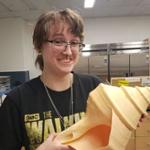
Environmental Science '29
I was contacted by Dr. Camila Alves Souto to participate in the project, as I have a background in fossil preparation and invertebrate paleontology. I have always found mollusks to be the most beautiful invertebrates in the oceans. From the humble oyster to the clever cuttlefish, I find their endless forms and ecological niches to be utterly fascinating. I focused primarily on how to organize the specimens in the display and verifying taxonomic relationships. Additionally, I have always wanted to aid in a public science display at Stockton, and as such, this project served as a fantastic lens and opportunity to get experience building a display from the ground up, as well as expose me to organisms I had not yet thoroughly accustomed myself to.
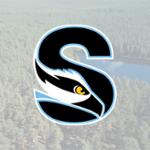
Biology
When Dr. Alves Souto mentioned this exhibit to me in the fall of 2024, I couldn’t wait to be a part of it. I worked on this exhibit in tandem with my other independent study, advanced printmaking, to create a promotional piece for it. I was simply overjoyed with my creation. The shells were brought together by an outside force, and although they aren’t exactly alike or share the exact same origin, together they form a beautiful showcase of our oceans’ diversity. As I aspire to be a scientific illustrator, I am thankful for this opportunity and hope to do more projects similar to this in the future!
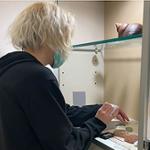
Marine Science '26

